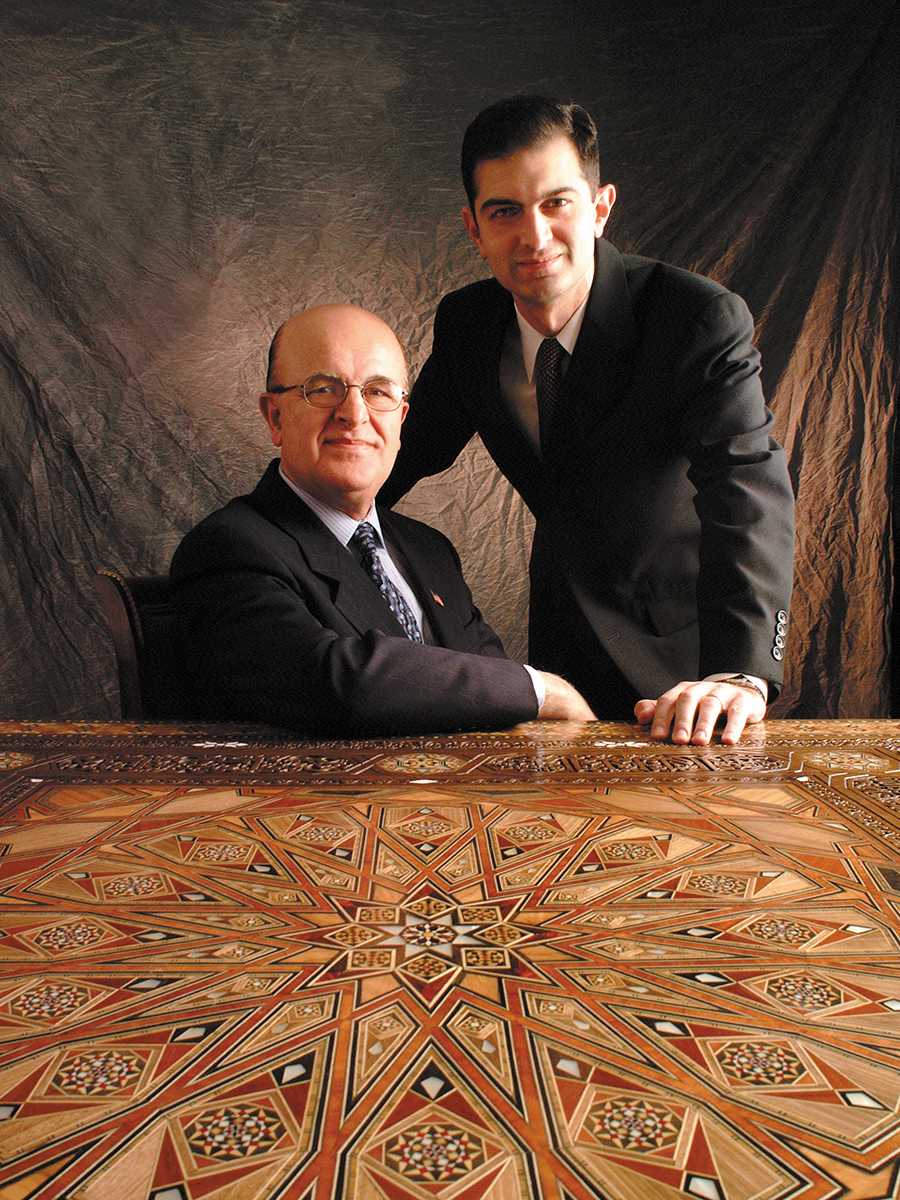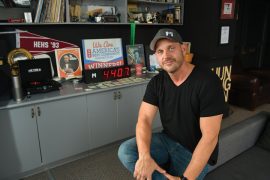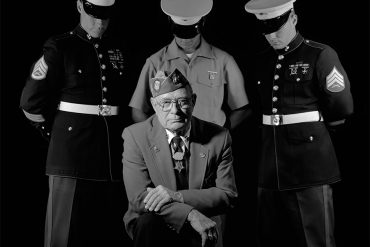Joseph B Touma, MD and his son Joe share a love of medicine and the Huntington community
By Tamara Endicott
HQ 43 | WINTER 2002
More than 30 years ago, Joseph B. Touma, M.D. began his medical practice in Huntington, and his life and the quality of life for countless others in this community were changed forever. The Touma name has become synonymous with medicine, history, art and civic responsibility. Dr. Touma’s contributions include a renowned medical practice,widely-used medical devices, a medical museum, an art gallery exhibiting treasures from the Near East, Central Asia and North Africa, and countless other contributions to the region. But if you were to ask him what he is most proud of today, he would smile warmly and tell you about the addition of a new associate to his practice that will continue the legacy he began in 1971.

His son, B. Joseph Touma, M.D. joined the practice in August, bucking the trend that has seen most of the region’s talented young people leave the area. After receiving his medical degree from West Virginia’s School of Medicine in 1994, he completed postgraduate work at WVU in surgery and otolaryngology. In the last two years, he has completed a neurotology fellowship at the University of Pittsburgh School of Medicine. At a time in his young career when he could have opted to practice medicine virtually anywhere in the country, Joe chose to return to Huntington and practice medicine side-by-side with his father.
“It’s a real honor to be able to work with your father,” says Dr. B. Joseph Touma. “I think it’s a pleasure for both of us. After having seen what his practice is like and how much fulfillment he gets out of it, it’s pretty unique to be able to share that with him. Even as a young boy I could see how he paid such attention to detail and had such concern for his patients. He really inspired me to strive to be the best at all the skills I’ve acquired.”

Dr. Touma is proud of both his children, and adds, “Let me brag about them a little bit. My son had terrific training in Pittsburgh and I am very proud of that. He went there and learned all of these modern techniques in the field of neurotology. My daughter is a lawyer. She spent two years in London working for a New York firm. She recently moved back to New York to work for the home office, so we’re excited about that. My daughter-in-law, Susan, is a chief resident in dermatology at WVU and will finish in a few months. We are looking forward to her return to Huntington.”
What Dr. Touma’s son has brought to the practice is vast experience in various types of Cochlear implants.
“Where he trained there was more work with a new generation of implants, not just the Cochlear implants,” Dr. Touma explains. “It is wonderful, at this point of my career, to watch a new otologist, to watch new blood starting from here and moving with a new wave of technology. It is amazing what the new technology will do for the hearing impaired.”
Dr. Touma is excited about the extensive experience his son will bring to the practice with Cochlear implants. The implants were designed for the severely hearing impaired due to meningitis, congenital hearing loss or progressive hearing loss. The device, only 3/4 inches in length and 1/2 inch wide, uses 10,000 transistors connected to electrodes that stimulate the nerve endings in the cochlea. Deaf patients are able to hear, and with the help of a speech therapist, can learn to communicate verbally. This technology is the most recent advance in otology and something that Dr. Touma only dreamed of when he began studying the field of otology.
Dr. Joseph B. Touma started his private practice on July 1, 1971. Located at 1616 Thirteenth Ave., the River Cities Ear, Nose and Throat Specialists P.L.L.C. and the Touma Ear and Balance Center also have offices in Teays Valley and Ashland, Ky. The practice offers specialized treatment in hearing aid services, head and neck surgery, audiology, deafness, balance disorders, sinus diseases, allergy and snoring.
His wife, Dr. Omayma Touma, is director of the Cabell County Health Department.
“Medicine is my interest and love,” says Touma. “I enjoy medicine so much and what I have seen in my field is phenomenal. I witnessed the early birth of modern microscopic ear surgery when it was only an idea that you dreamed of. I now experience that and I perform it, so it’s exciting for me to have practiced otology in this era.” Touma has contributed much to his field of specialization by inventing 14 medical devices. Some of his devices are used in practices across the nation. The Touma T-tube, manufactured by Micromedics in Minneapolis, MN, aids in draining fluid from the inner ear and the Touma “Universal” Prosthesis, manufactured by Xomed in Jacksonville, Fla., are used to replace missing bones in the middle ear.
Teaching has also been an important part of Dr. Touma’s career, and as clinical professor at both Marshall University and WVU medical schools for 26 years, he believes, “Our medical community, hospitals and facilities are really second to none. We have a medical school that is graduating wonderful physicians that can go anywhere in the country. We have people going to the Mayo Clinic. They are going everywhere. You name it and we have our graduates there. The beauty of it is that we can see them now filtering back over the past few years with wonderful training to help our people.”
His son also plans to teach, and says, “I hope to be involved not just in my clinical side, but have some academic involvement, especially with Marshall and West Virginia University teaching residents and presenting papers at various conferences.”

Dr. Touma values the importance of preserving the history of medicine and has created a 4,000 square foot medical museum that exhibits a 28-year collection of books, medical instruments, a turn-of-the-century dental office and drugstore, a 1913 doctor’s buggy and a 1926 Model-T Ford Doctor’s Coupe. A 280-piece ear trumpet collection, the largest in the world, is his favorite part of the museum, “because of my specialty.” The earliest ear trumpets were fashioned for the hearing impaired, 250 years ago, from animal horns and seashells. Touma recently purchased a statue from London that displays all the muscles in the body, but says he is satisfied with the museum and only adds to it the occasional rare piece.
The Touma Museum of Medicine, located at 314 9th St., is only open by appointment. He hopes the addition of Huntington’s Pullman Square will produce enough traffic to open it full-time. He has visited Steiner & Associate’s Easton Town Center in Columbus, Ohio, and is pleased with the plans for the Huntington project. The Toumas have been extensively involved in the restoration of many of Huntington’s downtown buildings and feel the design of the project is exactly what the downtown area needs.
Both Drs. Joseph B. and Omayma Touma are originally from Damascus, Syria. Thirty-one years ago, they were looking for a city with a strong and growing medical community, a university, a unique culture and a pleasant place to raise their family. After visiting 15 other cities, they were delighted when they discovered the city of Huntington, West Virginia nestled on the Ohio River.
“My wife and I chose Huntington over where we came from and over the rest of the United States,” says Touma. “We decided to join the community of Huntington, which means that you love it so much that you don’t miss other places too much. Both of us are veterans of two cultures and there is something positive and wonderful about being able to pick and chose the best from both. It gives you depth in your thinking and the way you treat people and the way you approach things. You have the richness of both cultures. It gives you choice.”
The Touma Near Eastern Gallery, opened in October 1998 in the Huntington Museum of Art, was a contribution they hope acts as a cultural bridge between their two cultures. After 30 years of collecting, Joseph and Omayma have left the museum with over 500 pieces of ceramics, glasswork, rugs, manuscripts, paintings, metalwork, weaponry and armor. One hundred pieces were selected to form “The Allure of the East” collection and toured the country for a three year period.
“Dr. Touma supports the museum in a number of different ways,” explains Mark Bugher, president of the Board of Trustees at the Huntington Museum of Art. “His family’s donation of the Touma Gallery is the most visible example, but he also chairs our collection committee which selects what artwork will be displayed each year. And beyond that, he supports every single activity that takes place at the museum. Last year, he bought dozens of museum memberships to give to colleagues as Christmas gifts. He’s the kind of supporter who shows up to every meeting and finds creative ways to take the museum to the next level.”
The Damascus Room, the centerpiece of the gallery, is only one of four in the United States and displays the intricate hand carving of artisans from the Sanadiki Workshop in Damascus. The ceiling, bookcases, arches and doors were carved from a walnut tree in Ein El-Fijeh, just outside Damascus, and required eight months to carve. The Toumas are very happy to have had the opportunity to share the beautiful art and craftsmanship of their homeland with Huntington.
Dr. Touma’s contributions to the medical community have also been far reaching. He is currently serving as president of the Huntington Medical Education Foundation and is past president of several local, state and national medical organizations. He has also published 13 medical articles, traveled to present 57 different lectures, produced 13 medical educational video programs and has taught several courses across the country.
“Dr. Touma is a dedicated medical professional,” notes Mike Sellards, C.E.O. of St. Mary’s Hospital. “He is involved in so many health-related organizations. He is one of the founders and current chairman of Huntington Medical Foundation a collaborative effort between St. Mary’s and Cabell Huntington Hospital to provide education and support to physicians in outlying regions. He has enthusiastically served as chairman of the Credentials Committee at St. Mary’s. And, it should be noted, he is an outstanding physician in his own right.”
Dr. Touma has received numerous medical and civic accolades, but is most proud of his Distinguished West Virginian Award given by Cecil Underwood in 1999 and his induction into the Greater Huntington Wall of Fame in 1997. In 1999, he was awarded the West Virginia Philanthropist of the Year Award. Touma says he never dreamt that an outsider could come to Huntington and have such honors bestowed on he and his wife. He describes his civic involvement as a “responsibility and a pleasure.”
In the last three decades, Touma has been a member of several organizations including the Rotary Club, the Huntington Chamber of Commerce and has served as a board member for the Marshall University Foundation, Huntington Museum of Art and Chamber of Commerce.

The couple received The Herald-Dispatch “Citizens of the Year” award in 2000 and both were inducted into Marshall University’s Business Hall of Fame in 2001. Together they have completed 16 downtown restoration projects and both hope the Pullman Square project will provide the economic boost Huntington needs.
“If you look at the architecture downtown, it is incredible,” says Dr. Touma. “When we started some of the restorations we couldn’t believe the materials people would use that covered up the older, more classic architectural style. The ornamentation they covered over was what really made these buildings unique. We were happy to help preserve some of that beauty. The downtown architectural flavor is what really pulled the developers into doing the Pullman Square project.”
Huntington and the state of West Virginia have honored the Toumas, but both would be a very different place if it weren’t for their dedication, contributions and love for preservation and restoration. Dr. Touma believes true success and happiness comes from working in a field that you love.
“People tell me, ‘After all these years, you still seem to be vibrant and excited.'” says Touma. “I always dreamed of becoming an ear specialist and surgeon and I had the chance to do it. I am so fortunate to get to do what I love.”





